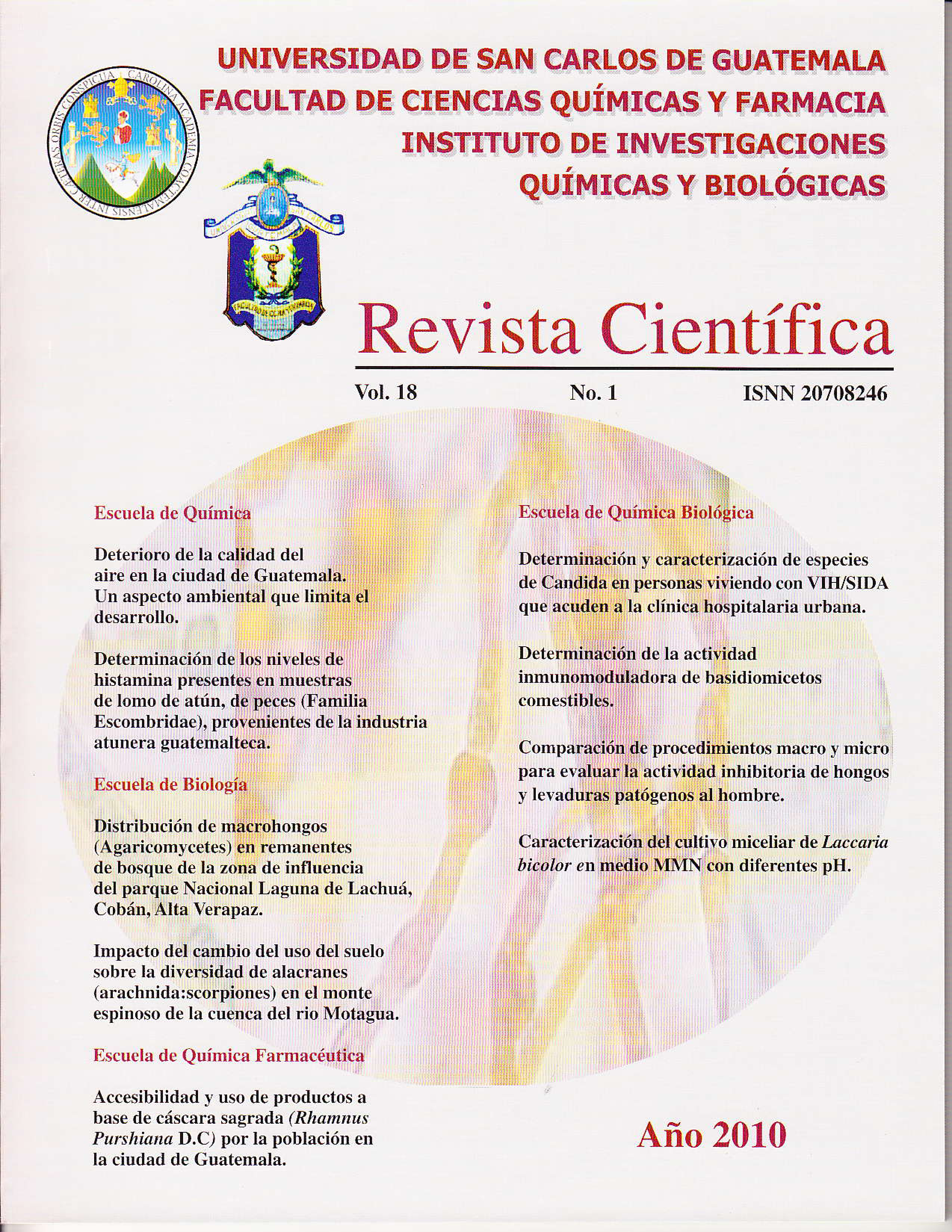Comparison of macro and micro procedures to evaluate the inhibitory activity of pathogenic fungi and yeasts to man
DOI:
https://doi.org/10.54495/Rev.Cientifica.v18i1.170Keywords:
inhibitory activity, fungus, yeasts pathogenic to humansAbstract
Screening for antifungal activity allows in vitro evidence of how a plant extract inhibits fungal growth under standard conditions. Currently, the Faculty of Chemical Sciences and Pharmacy uses the Agar Macrodilution methodology, which utilizes significant amounts of resources, materials, and time. As part of the globalization process, the National Committee for Clinical Laboratory Standardization (NCCLS) approved the plate microdilution technique as a standard for measuring antifungal activity. This technique, using minimal resources, provides results in less time. Despite its approval, it is not yet used in Guatemala for screening or for determining the minimum inhibitory concentration (MIC) of plant extracts. Therefore, the present study aimed to compare both techniques by evaluating 12 commonly used extracts against 4 ATCC strains of uniform yeast fungi and 6 ATCC strains of filamentous fungi, to determine whether the two techniques are comparable. The comparison of both techniques was carried out through a concordance study and with the use of the Student t test for means of two paired samples, it was shown that there is a significant difference between both, since a p value <0.025 was obtained. Thus, it could be concluded that the Microdilution technique in plate cannot yet replace the Macrodilution in agar, but both can be used simultaneously in order to combine their benefits. The fungicidal activity of the ethanolic extract of the 5. americaiutm leaf and the chloroformice extract of the L. graveolens leaf was verified.
Downloads
References
Quindós, G. (2002). Las micosis en el amanecer del siglo XXL Rev Iberoam MicoL 19, 1-4.
Loeffler, J. (2003). Antifungal drug resistance. Clin Infect Dis, 17, 31-41, https://doi.org/10.1086/344658 DOI: https://doi.org/10.1086/344658
Wheat, J. (1995). Endemic mycoses in AIDS: A clinical review, Clin Microbiol Rev. 8, 146-159, https://doi.org/10.1128/CMR.8.1.146 DOI: https://doi.org/10.1128/CMR.8.1.146
Perea, S. (2002). Antifungal resistance in pathogenic fungi. Clin Infect Dis 35, 1073- 1080, https://doi.org/10.1086/344058 DOI: https://doi.org/10.1086/344058
Gaitán, T. (2005). Actividad de doce plantas nativas Guatemaltecas contra Sporothrix schenkii. Tesis de licenciatura. Universidad de San Carlos de Guatemala.
Paz, A.M. (2005). Búsqueda de actividad contra especies de Campylobacter en plantas nativas de Guatemala. Tesis de maestría MUPLAM. Universidad de San Carlos de Guatemala.
Serrano M. (2005). Actividad in vitro de voriconazol y otros tres antifúngicos frente a dermatofitos. Sevilla, España: Servicios de Microbiología del Hospital Universitario de 16.
Brancato F. Golding NS. (1983). The Diameter of the mold colony as a reliable measure of growth. Micologia Vol. 45. (p.848-862), https://doi.org/10.1080/00275514.1953.12024321 DOI: https://doi.org/10.1080/00275514.1953.12024321
MD Pfaller, M.A, et al. (2002). Reference Method for Broth dilution antifungal susceptibility testing of filamentous fungi; approved standard. NCCLS Documento M38-A Vol. 22. No. 16.
Downloads
Published
How to Cite
Issue
Section
License
Copyright (c) 2010 P.A. Flores, M.J. Guancín, C.M. Ozaeta, A. Cáceres, I. Gaitán

This work is licensed under a Creative Commons Attribution 4.0 International License.
Authors who publish with this journal agree to the following terms:
- Authors retain copyright and grant the journal right of first publication with the work simultaneously licensed under a Creative Commons Attribution License 4.0 that allows others to share the work with an acknowledgement of the work's authorship and initial publication in this journal.
- Authors are able to enter into separate, additional contractual arrangements for the non-exclusive distribution of the journal's published version of the work (e.g., post it to an institutional repository or publish it in a book), with an acknowledgement of its initial publication in this journal.
- Authors are permitted and encouraged to post their work online (e.g., in institutional repositories or on their website) prior to and during the submission process, as it can lead to productive exchanges, as well as earlier and greater citation of published work.









